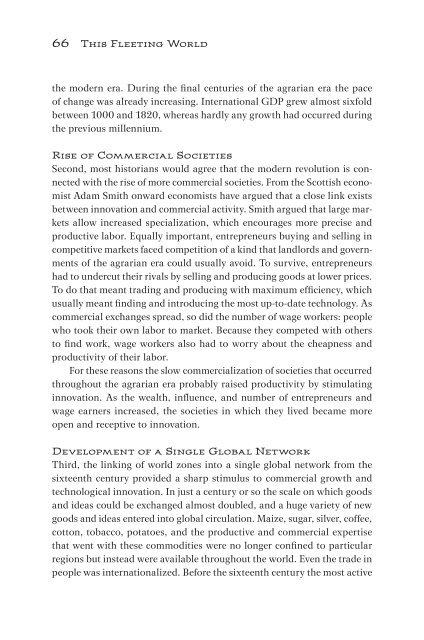This Fleeting World
This Fleeting World
This Fleeting World
You also want an ePaper? Increase the reach of your titles
YUMPU automatically turns print PDFs into web optimized ePapers that Google loves.
66 <strong>This</strong> <strong>Fleeting</strong> <strong>World</strong><br />
the modern era. During the final centuries of the agrarian era the pace<br />
of change was already increasing. International GDP grew almost sixfold<br />
between 1000 and 1820, whereas hardly any growth had occurred during<br />
the previous millennium.<br />
Rise of Commercial Societies<br />
Second, most historians would agree that the modern revolution is connected<br />
with the rise of more commercial societies. From the Scottish economist<br />
Adam Smith onward economists have argued that a close link exists<br />
between innovation and commercial activity. Smith argued that large markets<br />
allow increased specialization, which encourages more precise and<br />
productive labor. Equally important, entrepreneurs buying and selling in<br />
competitive markets faced competition of a kind that landlords and governments<br />
of the agrarian era could usually avoid. To survive, entrepreneurs<br />
had to undercut their rivals by selling and producing goods at lower prices.<br />
To do that meant trading and producing with maximum efficiency, which<br />
usually meant finding and introducing the most up-to-date technology. As<br />
commercial exchanges spread, so did the number of wage workers: people<br />
who took their own labor to market. Because they competed with others<br />
to find work, wage workers also had to worry about the cheapness and<br />
productivity of their labor.<br />
For these reasons the slow commercialization of societies that occurred<br />
throughout the agrarian era probably raised productivity by stimulating<br />
innovation. As the wealth, influence, and number of entrepreneurs and<br />
wage earners increased, the societies in which they lived became more<br />
open and receptive to innovation.<br />
Development of a Single Global Network<br />
Third, the linking of world zones into a single global network from the<br />
sixteenth century provided a sharp stimulus to commercial growth and<br />
technological innovation. In just a century or so the scale on which goods<br />
and ideas could be exchanged almost doubled, and a huge variety of new<br />
goods and ideas entered into global circulation. Maize, sugar, silver, coffee,<br />
cotton, tobacco, potatoes, and the productive and commercial expertise<br />
that went with these commodities were no longer confined to particular<br />
regions but instead were available throughout the world. Even the trade in<br />
people was internationalized. Before the sixteenth century the most active


